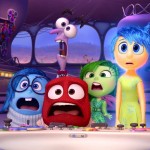 “Story” is what happens. It’s the narrative center. “Plot” is why it happens. It’s the emotional center. This should be familiar, if you read last week’s post on finding an idea. In Aspects of the Novel (1927), E.M. Forster put it this way: “‘The king died and then the queen died’ is a story. … ‘The king died and then the queen died of grief’ is a plot.”
“Story” is what happens. It’s the narrative center. “Plot” is why it happens. It’s the emotional center. This should be familiar, if you read last week’s post on finding an idea. In Aspects of the Novel (1927), E.M. Forster put it this way: “‘The king died and then the queen died’ is a story. … ‘The king died and then the queen died of grief’ is a plot.”
Songs should emerge from the plot (emotion), not comment on or describe the story (narrative). Songs are not relief from the action, they are the action, they are the moments when one domino falls into another, when the hero changes a little bit, when emotion bubbles to the surface — whether it’s joy, sadness, anger, fear, or disgust.
Writer John Kenrick believes three experiences (emotional crises) offer the best motivation for songs. First is transition. The character changes what they want, which changes what they do, like “Soliloquy” from Carousel. Second is realization. The character finally understands the effect of something done or left undone, like “The Party’s Over” from Bells Are Ringing. Third is decision. The character doubles down on a want or tactic, like “Don’t Rain on My Parade” from Funny Girl.
Once you know the motivation to sing, how do you sing about it? Bob Fosse believed there were two basic types of songs. First are “I Am” songs, essentially how a character feels about the way things are, either supporting or challenging the status quo, like “Jet Song” from West Side Story and “Belle” from Beauty and the Beast.
Second are “I Want” songs, about inviting or avoiding change, like “Over the Rainbow” from Wizard of Oz and “Wouldn’t It Be Loverly” from My Fair Lady. The conditional love song is a common variety of “I Want,” like “People Will Say We’re in Love” from Oklahoma! and “If I Loved You” from Carousel.
Fosse called everything else “new songs,” many of which serve as signposts on the journey of a musical, such as the “opening number,” which states who and what the story is about and how it will work, like “Comedy Tonight” from A Funny Thing Happened on the Way to the Forum.
Another is the “reprise,” which repeats all or part of a song, often with new words, to reflect a plot development, like “Let Me Entertain You” from Gypsy and “Agony” from Into the Woods.
A third is the “11 o’clock” (or “tent pole”) number, a climax that energizes the show toward the end of an act, like “Tevye’s Dream” from Fiddler on the Roof and “Sit Down, You’re Rockin’ the Boat” from Guys and Dolls.
And finally, there is the “finale,” which provides a powerful impression at the end of an act.
Listen to some theater songs and try to figure out the motivation and emotion behind them. Then identify the song moments in your show and the types of songs that would work for each.
Check your local library’s e-book and audiobook services for The Secret Life of the American Musical (2016) by Jack Viertel for more on song spotting. Before tomorrow’s post on lyrics, listen to Terry Gross’s 2012 NPR interview with Stephen Sondheim about lyric writing.
Other free offerings include weekly shows from National Theatre at Home, Andrew Lloyd Webber’s The Show Must Go On!, and the Off-Off-Broadway company HERE. There are also regular posts of the PBS Great Performances series, Disney on Broadway Live classes, and 54 Below At Home concerts.
Next, the lyrics.
